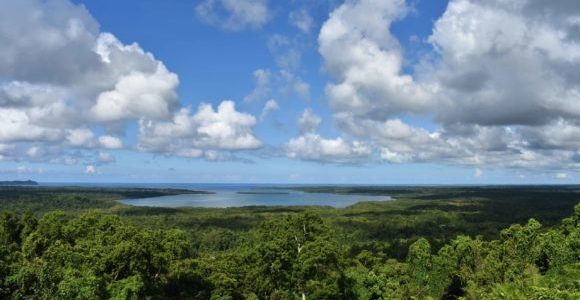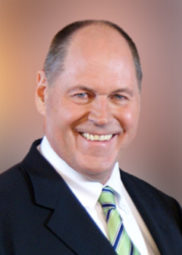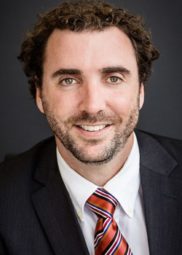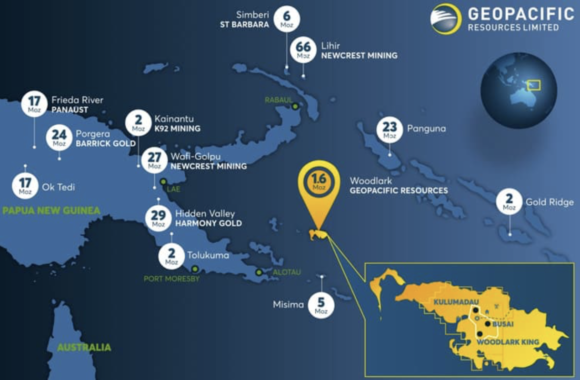Australian miner Geopacific Resources has secured funding to develop the gold mine on Papua New Guinea’s Woodlark Island in Papua New Guinea’s Milne Bay Province. Business Advantage PNG spoke exclusively to Chairman Ian Clyne and CEO Tim Richards about their expectations for the project.

Woodlark Island. Geopacific Resources acquired Kula Gold’s share in the Woodlark gold project in June 2019. Credit: Geopacific Resources
Business Advantage PNG: You’ve secured US$100 million (K350 million) in project financing for the development of a gold mine on Woodlark Island. Is this funding enough to get the project to production, or will more funding be needed?
Tim Richards (CEO, formerly General Manager Simberi Operations for St Barbara): We’re fully funded, including working capital, through to gold production. So, there’s no more equity required, no more debt.
BAPNG: Did you discover a reluctance among tier one lenders to invest in Papua New Guinea right now? Is that the reason why you ended up going to a second tier lender, Sprott Private Resource Lending?
TR: It’s probably a combination of factors. PNG as a jurisdiction raises flags, unfortunately. Australia doesn’t really assess PNG on its merits, but largely on perception. The other factor for the top tier lenders is that we’re a single asset company and a junior. It’s a much higher risk proposition. Sprott came to the party with the best proposition.
‘The level of support we’re provided is the best I’ve ever encountered in my time in Papua New Guinea.’
Ian Clyne (Chairman, formerly CEO of Bank South Pacific): They really liked the project. Whilst they’ve never done a deal in Papua New Guinea, they got comfortable with the country risk perspective. It was all about, for them, our execution capacity. That’s why, in mid-year, we stepped back and reassessed. The managing director resigned and then we went out looking for a team of extremely capable and motivated people with good PNG experience and we were very fortunate to have Tim come and join us.
BAPNG: What factors do you think impressed the funders?

Geopacific Resources’ Ian Clyne
IC: Bringing in a team, led by Tim, with his successes at Simberi and, additionally, complementing the board with the appointment of Sir Charles Lepani. As we all know, he’s one of the foremost diplomats Papua New Guinea has ever produced. He’s highly, highly ethical. He’s from the Trobriand Islands, so Woodlark is family for him. Having Sir Charles there has been a huge benefit and a clear sign to Papua New Guinea that we want to do the right thing. I think having Sir Charles, myself and Tim gave the lenders and investors a lot of confidence, as we know what we’re doing in Papua New Guinea.
I think the other aspect is the work that Tim and the team did throughout 2020, where we took the 2018 Feasibility Study and really gave it a good working over, not so much with a view to producing a document that the market would like, but very much a document that we could put our hand on our heart, go to the lenders and say, “This is what we think it’s going to cost. This is how we think it’s going to look when it’s delivered.” And this is going to be our Bible over the next two years.
BAPNG: How much of the reassurance is the fact that you have an existing mining lease (ML508) under the current mining laws?

Geopacific Resources’ Tim Richards
TR: We take comfort from the fact that the Prime Minister has come out on numerous occasions and publicly stated that he sees any new legislation as forward-looking and that he stands by all of the agreements for existing projects. That gives us a great deal of confidence. It’s been difficult to fault the Conservation and Environment Protection Authority, the Mineral Resources Authority, all of the government bodies and the mining minister himself. The level of support we’re provided is the best I’ve ever encountered in my time in Papua New Guinea.
‘Eighteen months from now, we’ll be producing gold but we’ll still be, fundamentally, a phenomenal exploration play.’
BAPNG: How do you see this project working for the community on Woodlark Island and Milne Bay Province?
TR: I can look at my experiences at Simberi (in New Ireland Province), which is quite comparable in terms of size. We saw a substantial amount of local businesses develop over the time that I was there, providing support services to the mine. That’s obviously the easiest form of business development.
The bigger challenge is to develop business initiatives that are sustainable and not mine-related. Because ultimately, whether the mine is there for 10 years or 20 years, it has a finite life and the community will go back to life without mining. The measure of our success as a partner in business development on the island is the development that we leave after we close.
At Simberi, we set up cocoa projects, which were highly successful and are producing chocolate now. Woodlark has the benefit of being a larger island with a larger population base. There’s a number of obvious opportunities for us to engage with the community, and the local and provincial governments,to develop initiatives in agriculture, tourism and fishing. For me, that’s actually a greater priority than participation in the mine, because the participation in the mine will come as a matter of course.

BAPNG: What infrastructure will the mine help to create on the island?
TR: Health and education. It’s the best legacy we can leave. We’ve already invested in a new school on the island. We’ve invested in clinics and we’ll be engaging very closely with the provincial education and health authorities, as well as the provincial administrator, to determine what sustainable infrastructure can be left on the island, post-mining. The infrastructure that we develop on the island has to be fit for purpose, both during operation and post mining.
BAPNG: How many local jobs and how many ex-pat jobs will this project create?
TR: Steady-state mining, we envisage in the region of 600 direct employees on the site. Of that 600, we would envisage 95–96 per cent of the workforce being Papua New Guinean. We’d like to achieve a minimum of 60 per cent Woodlark Island participation, with that number continuing to grow throughout the life of the mine, as skills on the island develop.
BAPNG: Are there any particular technical challenges to this project?
TR: Actually, that’s the beauty of the Woodlark project. It really is very simple geology. The metallurgy is benign, very straightforward. The processing approach that we’re using – 65 per cent of all gold projects in Australia use exactly the same layout. It’s a very well understood process, very simple to build, very simple to manage. Within PNG, the vast majority of PNG mining workers have had experience in operating these style of plants.
The only issue with the geology is we simply haven’t got enough drill holes in the ground yet. There’s exploration outside and we just haven’t defined just how big this thing’s going to be. But, in the scheme of things, that’s a pretty good problem to have.
BAPNG: The deposit could be bigger as you explore beyond the original lease area?
TR: We still don’t understand what we’ve got on the mining lease. Eighteen months from now, we’ll be producing gold but we’ll still be, fundamentally, a phenomenal exploration play. It’s just that we’ll be generating revenue while we explore. I’m as excited about the exploration aspect of this project as I am about bringing it into production.
IC: The potential of the existing pits is enormous and one of those is where the village of Kulumadau is. We’re moving the village – we’ve built just over a hundred structures to date. It’s been extremely well received. The whole village will be moved by October.
TR: It’s a phenomenal position to be in. We’ve funded the mine, we’re building. We will go into production next year, but both of our two main pits, which comprise 90% of our resource base, are still open in all directions. So, there’s plenty of room for growth and while the economics, as they stand now, are compelling, there’s a lot of room to improve them as well.
IC: We’ve been in full build mode since April, despite the ongoing finalisation of the debt package. We have no doubt we’re going to deliver a successful project, and a project that the community has wanted for many years.








Speak Your Mind